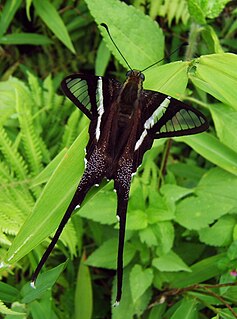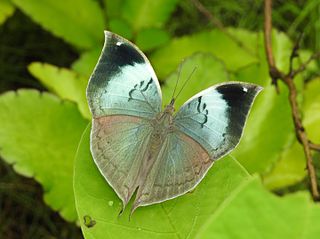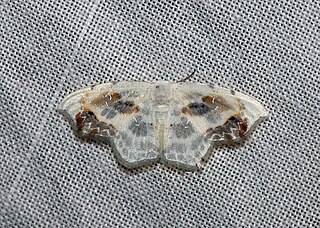
Graphium antiphates, the five-bar swordtail, is a species of papilionid butterfly found in south and southeast Asia. The species was first described by Pieter Cramer in 1775.

Lamproptera curius, the white dragontail, is a species of swallowtail butterfly native to parts of South Asia and Southeast Asia where it is common. It belongs to the dragontails genus, Lamproptera, of the swallowtail family, Papilionidae.

Miletus symethus, the great brownie, is a small butterfly found in India that belongs to the lycaenids or blues family. The species was first described by Pieter Cramer in 1777.

Kallima horsfieldii, the blue oakleaf, southern blue oakleaf or Sahyadri blue oakleaf, is a nymphalid butterfly found in India. The underside appears like a leaf complete with midrib while the upperside is brilliantly coloured.

Iraota timoleon, the silverstreak blue, is a species of lycaenid or blue butterfly found in Asia.

Horaga onyx, the common onyx, is a species of lycaenid or blue butterfly found in Asia.
Spectroreta is a monotypic moth genus belonging to subfamily Drepaninae erected by Warren in 1903. Its only species, Spectroreta hyalodisca, was described by George Hampson in 1896.

Grammodes stolida, the geometrician, is a moth of the family Erebidae. The species was first described by Johan Christian Fabricius in 1775. It is found in Africa, southern Europe, most of Asia and Australia. It migrates to central and northern Europe as far north as England, Denmark and Finland.

Aglais caschmirensis, the Indian tortoiseshell, is a species of nymphalid butterfly found in the northern regions of the Indian subcontinent, primarily in the Himalayas.

Lophocampa affinis is a moth of the family Erebidae. It was described by Walter Rothschild in 1909. It is found in Mexico.
Correbia meridionalis is a moth of the subfamily Arctiinae. It was described by Rothschild in 1912. It is found in Ecuador.

Erruca cardinale is a moth of the family Erebidae and described by George Hampson in 1898. It is found in Brazil. While São Paulo was where E. cardinale was first encountered, this moth is also found in other parts of Brazil like Santa Catarina, specifically in the towns of Bom Jardim da Serra, Brusque, Joinville and São Bento do Sul. Erruca cardinale is described as a day-flying moth, meaning that unlike most species of moth it is active during the day and sleeps at night. In volume one of the Catalogue of the Lepidoptera Phalaenae (1898) E. cardinale is described as follows:
Black-brown; antennae white at tips; tegulae with white points; patagia with crimson patches; legs with white spots; abdomen with lateral patches of crimson at base, and dorsal and two lateral series of white points, the 1st dorsal spot large; wings hyaline, the veins and margins black. Fore wing with crimson spot below base of median nervure and patch on basal part of inner margin followed by a whiteish mark; a discocellular black patch; the terminal band very wide on apical area and expanding at tornus; cilia white at apex. Hind wing with the innter area brilliant crimson; the terminal band expanding slightly at apex and above tornus.

Cosmosoma impar is a moth of the family Erebidae. It was described by Francis Walker in 1854. It is found in Mexico,
Episcepsis demonis is a moth of the family Erebidae. It was described by Herbert Druce in 1896. It is found in Panama and Peru.

Episcepsis venata is a moth of the family Erebidae. It was described by Arthur Gardiner Butler in 1877. It is found in Mexico and the Amazon region.
Mimagyrta abdominalis is a moth of the subfamily Arctiinae. It was described by Rothschild in 1912. It is found in French Guiana, Surinam and Venezuela.
Syllepte tumidipes is a moth in the family Crambidae. It was described by George Hampson in 1912. It is found in Cameroon, the Democratic Republic of the Congo, Gabon, Ghana, Nigeria and Sierra Leone.
Sameodes furvipicta is a moth in the family Crambidae. It is found in Papua New Guinea.

Leucoblepsis renifera is a moth in the family Drepanidae. It was described by Warren in 1900. It is found on Peninsular Malaysia, Sumatra and Borneo.
Gogana abnormalis is a moth in the family Drepanidae first described by Warren in 1897. It is found on Borneo, Sumatra and Peninsular Malaysia.












